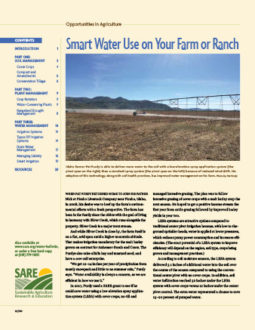Certain varieties of grain crops can perform well in dry conditions and can help conserve moisture. Likewise, certain cover crops help farmers and ranchers conserve soil moisture. Look for crops that work in your specific climate and that might provide a market advantage.
For example, cotton is a significant water user. Texas accounts for 45 percent of the total U.S. cotton supply, with most of that concentrated in the state’s High Plains region. Water levels are declining at an alarming rate in the Ogallala aquifer, the main water source for Texas cotton.
Long-term research led by the Texas Alliance for Water Conservation and funded in part by SARE has shown that rotating cotton with perennial forages that are adapted to dry conditions uses 24 percent less water than a cotton monoculture. What’s more, such a diversified system opens a door to profitable beef marketing opportunities.
When plant residue is left on the soil surface, water infiltration increases and evaporation decreases, so there is less moisture stress during drought. Lightly incorporated cover crops can trap surface water and add organic matter to increase infiltration to the root zone.
Especially effective at covering the soil surface are grass-type cover crops, such as rye, wheat and a sorghum-sudangrass hybrid. Some water-efficient legumes, such as medic and Indianhead lentils, provide cover crop benefits in dryland areas while conserving more moisture than fallow.
Heritage Grains
Native Seeds/SEARCH, an organization in Arizona that promotes arid-adapted crop diversity, worked with a team of farmers and researchers to successfully reintroduce two heritage grains to the arid Southwest. Supported by a SARE grant, the team evaluated Chapalote flint corn and White Sonora wheat for their capacity to reduce water use and enhance both soil fertility and moisture-holding capacity. They chose Chapalote corn for its reputation of performing well during dry years with little supplemental irrigation. White Sonora wheat was similarly selected for its drought tolerance. Using these heritage varieties, they reduced their seed, water and nitrogen inputs by up to 50% compared to conventionally grown varieties. Native Seeds/SEARCH restored local production of this heritage grain and helped support the community by enlisting members to produce value-added products from the grain.
Regional Crops
Researchers and farmers in different states have evaluated such water-conserving species as hulless barley, quinoa and pearl millet. Washington State University researchers in the Palouse region of Idaho and Washington tested hulless barley and quinoa on dryland, no-till farms for seeding rate, nitrogen supply and yield. Evaluation of quinoa revealed farmer enthusiasm, but continued research is needed on combining agronomic practices with varieties that can tolerate drought conditions. Results with food-grade barley were much more favorable. Barley yielded reliably across three years of research on participating farms, and the team identified optimum seeding and fertility rates. They released a new cultivar of hulless barley with nutritional characteristics that are attractive to the health-food market.
Pearl millet is one of the most drought-resistant commercial grains. It can grow in areas that experience frequent dry weather during the plant’s vegetative or reproductive phases. This warm-season annual grass has a high protein content and a short maturing season that allows it to fill a midsummer, double-crop production niche. Pearl millet appears to be more tolerant of sandy and acidic soils than other summer crops, is deep rooted, and takes up residual nitrogen, phosphorus and potassium. The grain is used in poultry and livestock rations, and is a good option for wildlife plantings and birds. Opportunities also exist in health-food outlets and in beer brewing.
Other drought-tolerant crop alternatives, especially in the South, include sesame and cowpeas.
